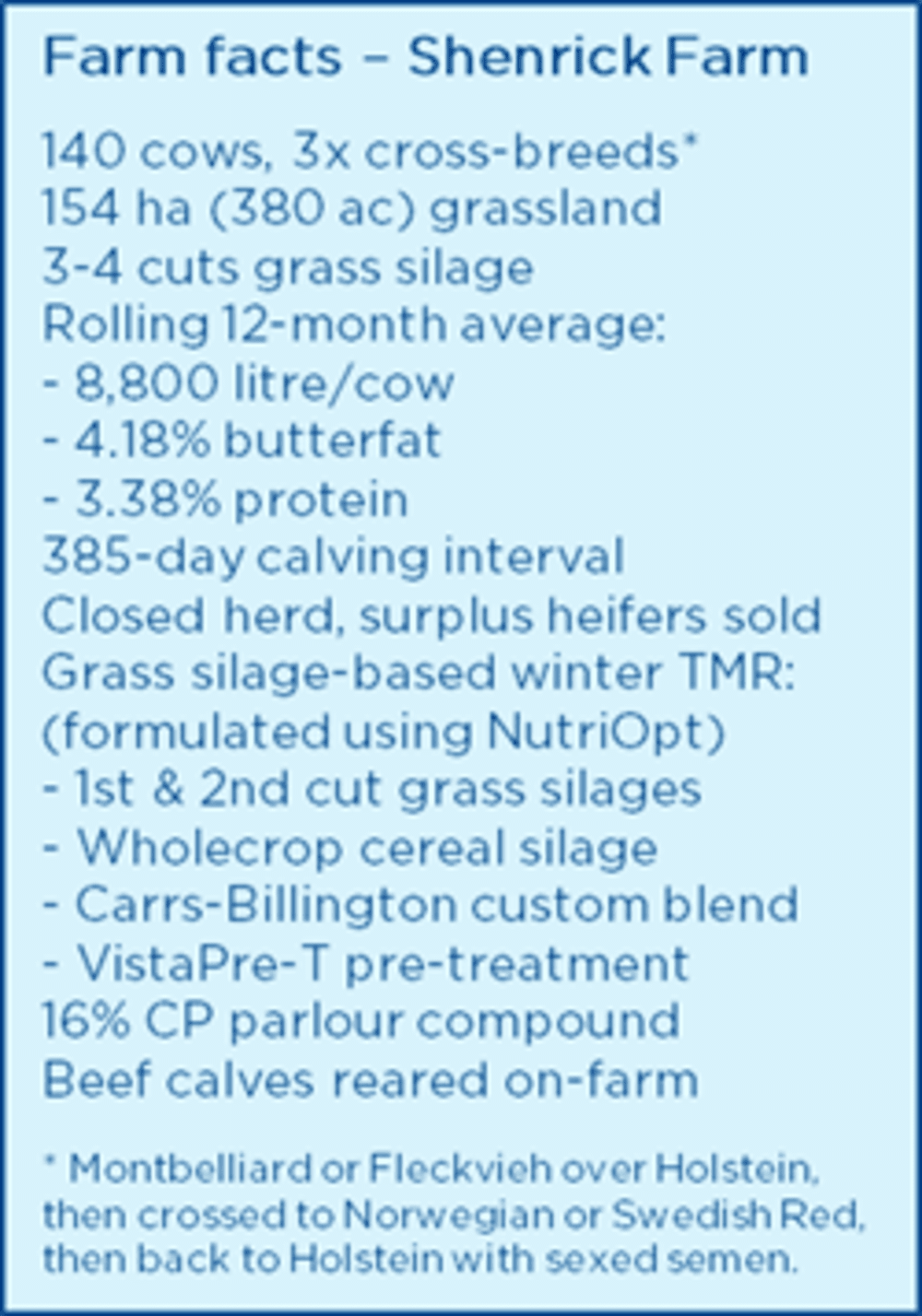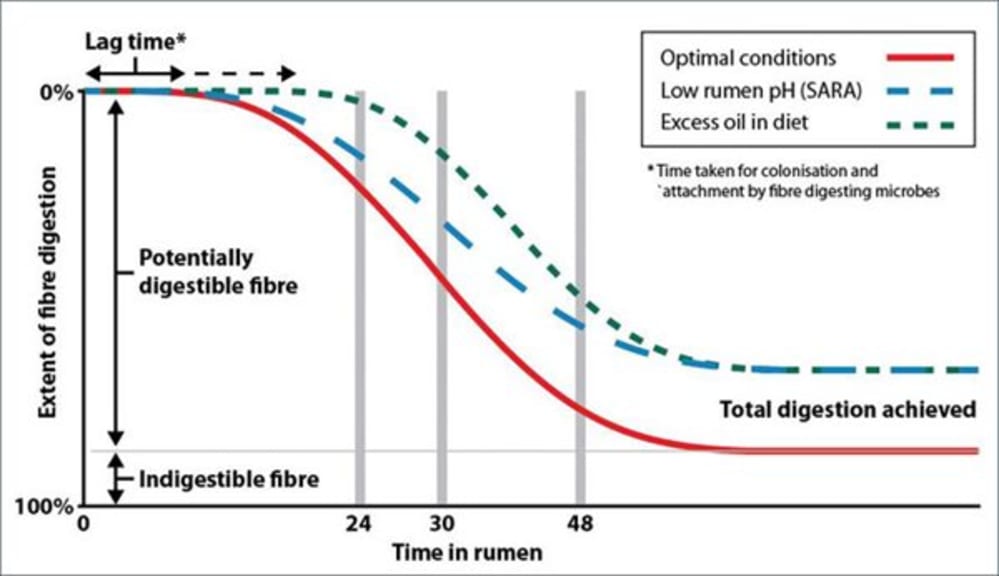Improved fibre digestion boosts milk yields for Dumfries farmer
Published Monday, 30th October 2017
Total dietary fibre typically accounts for 45-50% of the dry matter (DM) in most dairy rations, yet the gains possible from improving the digestibility of that fibre are too often overlooked, claims Dr Nicola Walker, AB Vista’s Global Ruminant Technical Manager.
“Dietary fibre is important both as an energy source and for correct rumen function, but it’s one of the slowest digesting fractions within the diet,” she explains. “Any improvements in fibre digestion can therefore significantly improve overall diet digestibility and the amount of milk produced from all feeds, not just forage.
“When rumen conditions are optimal, the rumen digestibility of the plant cell walls that make up most of this fibre is around 65%. However, what’s actually digested is typically much lower, and can be as low as 35% when conditions in the rumen really deteriorate due to the inclusion of high levels of concentrate causing sub-acute ruminal acidosis (SARA).”
Fibre digestion restrictions
Sub-acute ruminal acidosis (SARA), for example, limits the rate – and extent – of fibre digestion by reducing the activity of fibre-digesting microbes (see Figure 1, blue line). Excess oil in the diet can produce a similar effect by coating dietary fibre, slowing microbial attachment and colonisation, and so extending the lag time before digestion begins (see Figure 1, green line).
Higher rumen outflow rates will also cut the time available for microbial digestion, such as if feeding sodium bicarbonate to correct rumen pH, if water intakes rise in hot weather or if overall dietary fibre levels are too low.
Figure 1 – Graph showing the impact of rumen conditions on the rate and extent of fibre digestion (Source: adapted from USDA-ARS, 2014)
“Many of the best value feeds used in ruminant diets – grazed grass, silages, moist feeds – supply the majority of their energy as digestible fibre, but that energy is only available if the fibre is actually digested,” Dr Walker continues. “Higher levels of fibre digestion also improve the balance of the volatile fatty acids (VFA) that supply energy to the cow.”
Improving rumen function
Optimising fibre digestion should therefore be a top priority, advises Dr Walker. Formulate diets that reduce the risk of SARA, consider slow-release conditioners and live yeasts to improve rumen function, and minimise lag time before digestion begins by keeping overall oil and fat content below 5%.
“Recent research has shown that even a one-hour reduction in the time it takes for rumen microbes to colonise the fibre in the diet can raise total mixed ration (TMR) digestibility (D-value) from 63% to 67%,” she states.
“Achieved by adding the fungal extract-derived pre-treatment VistaPre-T to the ration prior to feeding, the result was an extra 1.3 litres/cow and greater milk protein (3.70% vs. 3.58%) for the same feed consumed, thanks to an increase in feed efficiency from 1.43 to 1.60.”
On-farm yield increase
Similar benefits have also been seen on-farm. For Ian Burgoyne, who milks 140 cross-bred cows near Crocketford, Dumfries, using the VistaPre-T pre-treatment increased average daily yield by around 1 litre/cow.
“Last winter we were looking at the options to increase milk output, but without buying more feed,” he explains. “We wanted to get more out of the high proportion of grass silage we feed, and improving fibre digestion by pre-treating that silage made a lot of sense.”
Pre-treatment works by roughening and creating pits in the surface of the fibre, increasing the rate and extent of colonisation by fibre-digesting rumen microbes. This reduces the lag time before fibre digestion begins, and samples of the silage tested on-farm with a hand-held NIR analyser showed the potential to raise silage energy levels from 11.1 to 11.9 MJ ME/kg DM.
Rations are formulated by Carrs-Billington nutritionist Mark Worden using the latest rationing system from Trouw Nutrition, which more effectively models the nutritional value each feed provides. Most of the total mixed ration (TMR) ingredients – including maize, wheat, brewers’ grains and bypass protein – are combined into a single custom blend.
Cow energy status

“For a start, the cows had shinier coats and looked more content. Then as we continued through the winter we found that fertility was also improving, which we put down to an improvement in the overall energy status of the cows.
“We’re 100% grass-based in terms of forage, so having the cows get more energy out of the grass silage we make – and the ration as a whole – can have a big impact over time.”
Latest news
Stay ahead with the latest news, ideas and events.

Online Feed Fibre Calculator
Calculate the percentage of dietary fibre in your feed
Our calculator is designed for nutritionists and uses averages of global raw materials to calculate the dietary fibre content (plus other more in-depth fibre parameters) of finished animal feed. These parameters are available within AB Vista’s Dietary Fibre analysis service (part of our NIR service).
Sign up for AB Vista news
A regular summary of our key stories sent straight to your inbox.
SUBSCRIBE© AB Vista. All rights reserved 2025
Website T&Cs Privacy & Cookie Policy Terms & Conditions of Sale University IDC policy Speak Up Policy

























